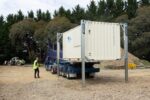Movac invests in Revolution Fibres to scale global growth
Auckland-based Revolution Fibres has raised $6m in a Series A funding round led by Movac, New Zealand’s most experienced technology investment firm. Founded in 2009 by Iain Hosie, Simon Feasey and Michael Perrett, Revolution Fibres has developed a unique technology to produce electro-spun nanofibres for use in a wide range of applications, such as filtration, skincare, sound absorption and composite reinforcement. Revolution Fibres has 15 employees and achieved early sales traction in several markets. Movac Partner David Beard comments “We have been targeting an IP-based business for Fund 4 for some time, and we were compelled to invest in Revolution Fibres because it had made a significant transition from R&D into scale volume manufacturing. With its applications spanning a diverse set of industries, it can adjust quickly and take advantage of a rapidly changing environment. We are delighted to have led this round which has included a diverse set of investors from NZ, US and Asia.” Revolution Fibres Chairman Andrew Turnbull comments “Iain and the team at Revolution Fibres have built a fantastic platform technology which is now ready, with the right team and funding, to be scaled. We’re very focussed on what we want to do with the business and sought an investor who understands what it takes to build a global deep tech business from New Zealand. Movac’s investment style and their experience in helping to grow value in companies with deep intellectual property meant a lot to us. Most importantly, there’s also a strong fit in terms of approach and aspiration.” The funding will be used to accelerate commercial opportunities in key offshore markets, and to invest further in production capability. Mr Beard will join the Revolution Fibres board. Phil McCaw, Movac Managing Partner commented, “We’re excited to have the opportunity to work with the Revolution Fibres […]










